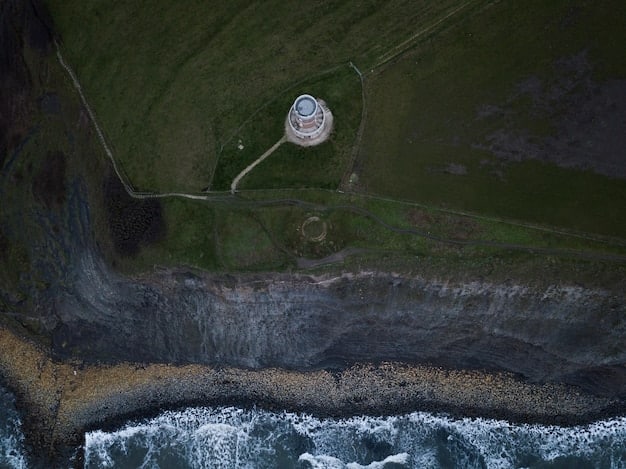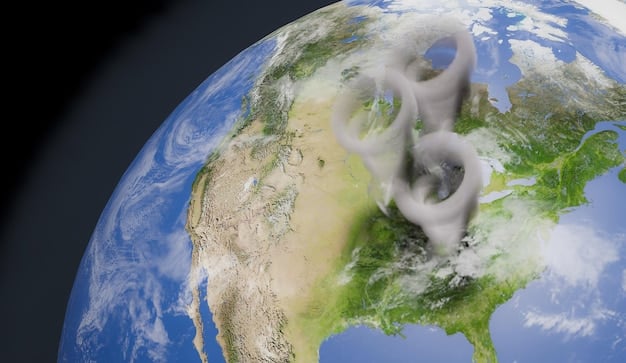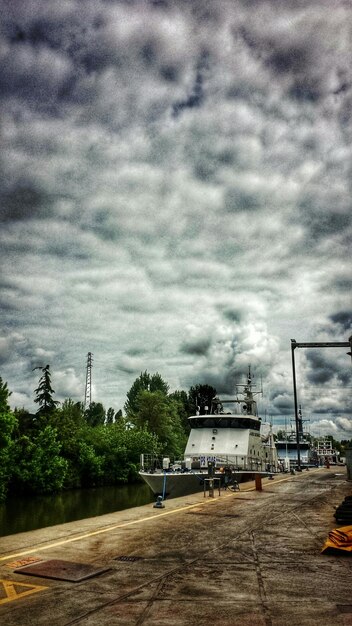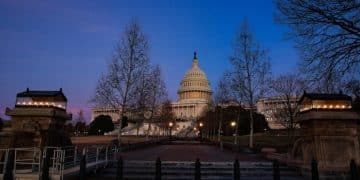Climate Change and US Security: Understanding the Global Impact

The impact of climate change on global security from a US perspective reveals how environmental shifts exacerbate existing threats, creating new challenges for national defense and international stability.
The escalating impact of climate change on global security: A US perspective demands urgent attention. As environmental shifts intensify, understanding the implications for American safety and global stability becomes paramount.
Understanding the Climate-Security Nexus
The relationship between climate change and global security is multifaceted. It extends beyond mere environmental concerns, impacting political stability, resource availability, and human migration patterns.
Defining the Climate-Security Nexus
The climate-security nexus refers to the complex interaction between climate change and various aspects of human and national security. This includes food security, water security, and overall political stability.
- Climate change acts as a threat multiplier, exacerbating existing tensions.
- Resource scarcity, driven by climate change, can lead to conflicts.
- Extreme weather events displace populations, creating humanitarian crises.

In essence, climate change doesn’t directly start wars, but it significantly intensifies the factors that lead to instability and conflict. Understanding this nexus is crucial for effective policymaking in the US.
Climate Change as a Threat Multiplier
Climate change acts as a threat multiplier, amplifying existing vulnerabilities and stressors in societies worldwide. This phenomenon has profound implications for US national security.
Exacerbating Existing Conflicts
Climate change can worsen existing conflicts by straining resources and displacing populations. This creates fertile ground for radicalization and recruitment by extremist groups.
For example, prolonged droughts can lead to crop failures, driving people to desperation and potentially into the hands of extremist organizations promising food and security.
Increased Risk of Humanitarian Crises
More frequent and intense extreme weather events, such as hurricanes and floods, can overwhelm existing infrastructure and response capabilities. This leads to humanitarian crises that require international assistance.
- Rising sea levels threaten coastal communities and military installations.
- Extreme heat waves impact troop readiness and operational effectiveness.
- Increased frequency of natural disasters strains disaster relief resources.
The US military must adapt to these challenges by investing in climate resilience and incorporating climate risks into its strategic planning.
The Impact on US Military Readiness and Infrastructure
Climate change poses direct threats to US military readiness and infrastructure. Rising sea levels, extreme weather events, and changing environmental conditions affect bases, equipment, and personnel.

Vulnerability of Coastal Bases
Many US military bases are located in coastal areas and are vulnerable to rising sea levels and storm surges. This puts critical infrastructure at risk and threatens operational capabilities.
For instance, Naval Station Norfolk, the largest naval base in the world, is increasingly threatened by rising sea levels, potentially impacting its ability to support fleet operations.
Impact on Training and Operations
Extreme heat and changing weather patterns can impact training exercises and operational effectiveness. Soldiers and equipment may not be able to perform optimally under these conditions.
- Extreme heat can lead to heatstroke and other heat-related illnesses among troops.
- Changes in precipitation patterns can affect military logistics and supply chains.
- Increased wildfire risk can impact training areas and base operations.
The military must invest in climate-resilient infrastructure and adapt training programs to account for changing environmental conditions.
Resource Scarcity and Geopolitical Competition
Climate change-induced resource scarcity, particularly water and arable land, can intensify geopolitical competition and lead to conflicts between nations.
Water Scarcity as a Source of Conflict
Water scarcity can exacerbate tensions between countries sharing water resources, such as the Nile River or the Mekong River. This can lead to disputes over water rights and access.
For example, the Grand Ethiopian Renaissance Dam on the Nile River has created tensions between Ethiopia, Egypt, and Sudan, highlighting the potential for water scarcity to drive conflict.
Competition for Arable Land
Climate change can reduce the availability of arable land, especially in regions dependent on agriculture. This can lead to competition for land and displacement of populations.
- Desertification and land degradation threaten agricultural production in vulnerable regions.
- Rising sea levels inundate coastal farmlands, reducing agricultural outputs.
- Changes in rainfall patterns disrupt agricultural cycles and lead to crop failures.
The US needs to work with international partners to manage resource scarcity and prevent conflicts arising from environmental pressures.
Climate Migration and Humanitarian Catastrophes
Climate change-induced migration and displacement pose significant challenges for global security. Mass movements of people can strain resources, destabilize communities, and create humanitarian crises.
Drivers of Climate Migration
Climate migration is driven by a combination of factors, including extreme weather events, sea-level rise, and resource scarcity. People are often forced to leave their homes in search of safety and sustenance.
For example, rising sea levels are displacing communities in low-lying island nations, leading to migration to other countries or regions.
Impact on Host Communities
Large-scale migration can overwhelm host communities, straining resources and services. This can lead to social tensions and even conflict between migrants and host populations.
- Increased demand for housing, water, and sanitation.
- Competition for jobs and economic opportunities.
- Cultural clashes and social friction.
The US needs to develop strategies to address climate migration and provide humanitarian assistance to affected populations.
Policy Recommendations and the US Role
Addressing the security implications of climate change requires a comprehensive and coordinated approach. The US has a critical role to play in mitigating climate change, adapting to its impacts, and promoting global stability.
Investing in Climate Mitigation
Reducing greenhouse gas emissions is essential to mitigate the long-term security risks of climate change. This requires transitioning to a low-carbon economy and investing in renewable energy technologies.
The US can lead by example by setting ambitious emissions reduction targets and investing in clean energy research and development.
Strengthening Climate Resilience
Building climate resilience is crucial to protect US military assets and communities from the impacts of climate change. This requires investing in infrastructure improvements, disaster preparedness, and early warning systems.
- Reinforcing coastal defenses to protect military bases from sea-level rise.
- Developing drought-resistant crops to enhance food security.
- Improving early warning systems to provide timely alerts about extreme weather events.
Furthermore, international cooperation is an imperative for the U.S. and its allies.
Enhancing International Cooperation
Addressing the security implications of climate change requires international cooperation. The US should work with its allies and partners to promote climate action, provide humanitarian assistance, and manage resource scarcity.
| Key Aspect | Brief Description |
|---|---|
| ⚠️ Threat Multiplier | Climate change intensifies existing vulnerabilities like resource scarcity. |
| 🌊 Infrastructure Risk | Coastal US military bases are threatened by rising sea levels. |
| 🌍 Geopolitical Tensions | Resource scarcity exacerbates tensions between nations. |
| 🏠 Climate Migration | Displacement creates humanitarian catastrophes and strains resources. |
Frequently Asked Questions
▼
Climate change amplifies existing stressors like resource scarcity and political instability, leading to increased conflict and humanitarian crises. It does not directly cause conflict but worsens underlying conditions.
▼
Coastal military bases are highly vulnerable to rising sea levels and storm surges. Extreme heat and changing weather patterns also affect training and operational readiness across various military installations.
▼
The military can invest in climate-resilient infrastructure, adapt training programs for extreme conditions, and incorporate climate risks into strategic planning. This ensures continued operational effectiveness.
▼
Climate migration occurs when environmental changes force people to leave their homes. Large-scale movements can strain resources and destabilize communities, leading to humanitarian crises and potential conflict.
▼
The US should invest in climate mitigation efforts, strengthen climate resilience through infrastructure improvements, and enhance international cooperation to address the security implications of climate change effectively.
Conclusion
The impact of climate change on global security: A US perspective reveals a complex challenge demanding immediate and comprehensive action. By understanding the climate-security nexus, investing in mitigation and adaptation strategies, and enhancing international cooperation, the US can safeguard its national interests and contribute to a more stable and sustainable world.





